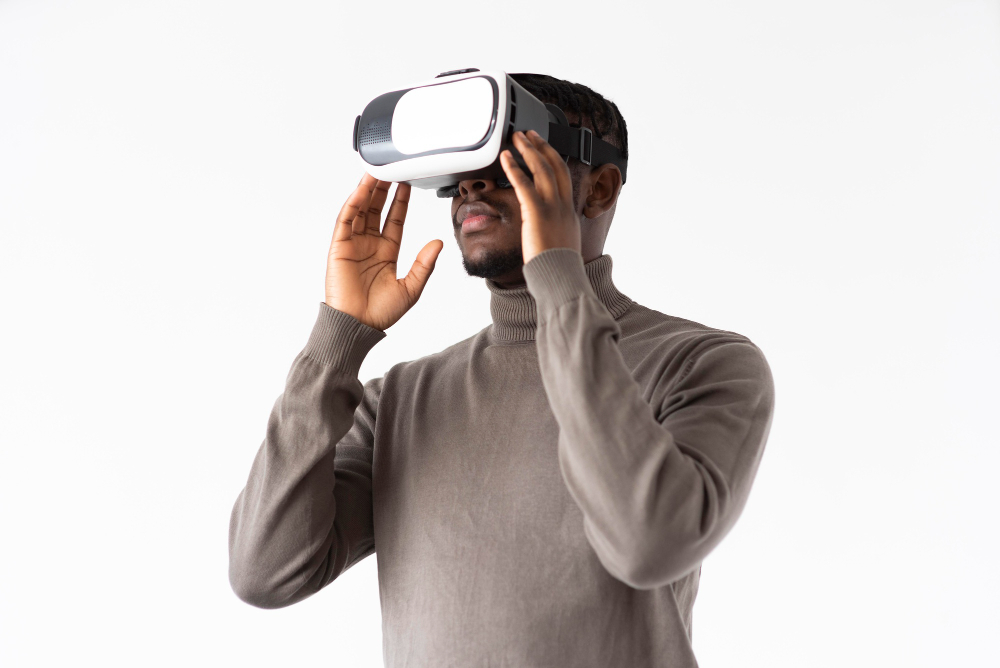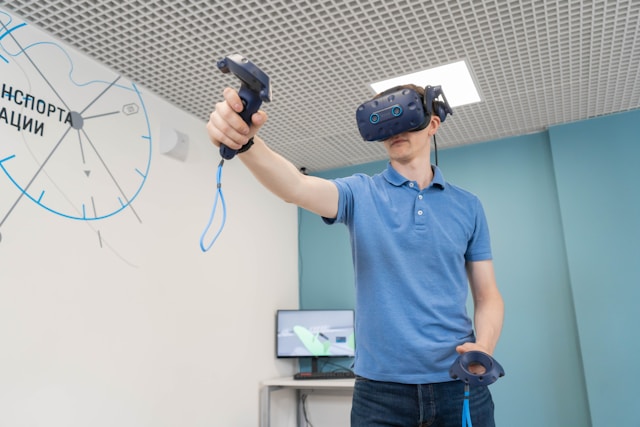As virtual reality (VR) technology advances, its ability to mimic the physical world continues to evolve. One of the most transformative innovations contributing to this immersive realism is haptic feedback. By enabling users to “feel” virtual objects and environments, haptics is expanding the boundaries of digital interaction. This evolution is particularly significant in the design and function of the user interface (UI), which serves as the critical bridge between humans and machines.
Traditionally, user interface design has been visually and audibly driven, focusing on screen elements, buttons, sounds, and gestures. But as VR becomes more sophisticated, the need for touch-based interactions becomes crucial. Haptic feedback introduces a new dimension to UI design, making virtual experiences more realistic and intuitive.
This article delves deep into how haptic technology is shaping the next generation of user interfaces in virtual reality. From current applications and challenges to future trends and societal impacts, we explore the multifaceted world of touch-enabled VR environments.
The Basics of Haptic Feedback
Haptic feedback refers to the simulation of tactile sensations using vibrations, forces, or motions to provide physical responses to user actions. This feedback can be delivered through gloves, controllers, suits, or even full-body gear that stimulates different parts of the body to mimic real-world sensations.
In the realm of virtual reality, haptic feedback adds an essential layer of realism. Users can now feel the recoil of a virtual weapon, the texture of a surface, or even the handshake of a virtual avatar. These physical sensations significantly enhance the user interface by making interactions more natural and responsive.
Modern haptic systems use a variety of technologies, including piezoelectric actuators, ultrasonic vibrations, and electroactive polymers. These innovations help simulate various tactile experiences and are being integrated into devices designed for gaming, healthcare, training, and more.
Evolution of Haptic Feedback in User Interfaces
The concept of haptic feedback isn’t new. It dates back to the early days of mechanical engineering and robotics, where simple vibrations indicated warnings or alerts. However, the integration of haptics into user interface design has seen rapid advancement in the past decade.
Early user interfaces focused on visual cues, then transitioned to auditory feedback, and now are increasingly incorporating tactile feedback. Devices like the Nintendo Wii Remote and PlayStation DualSense controllers have already demonstrated the potential of haptics in gaming. Now, VR developers are taking it further with full-body suits and touch-sensitive controllers.
The evolution of haptics within the UI realm signifies a broader shift in human-computer interaction—from passive observation to active participation. As interfaces become more multisensory, users can engage with digital environments in a way that closely resembles real-life experiences.
The Importance of Multisensory User Interfaces
Human perception relies on multiple senses working together. When visual, auditory, and tactile stimuli are combined in a user interface, the result is a more immersive and engaging experience. Haptic feedback complements other sensory inputs by adding physical context to digital interactions.
For example, in a VR simulation for surgical training, the ability to feel resistance when cutting tissue adds depth to the learning experience. It not only increases skill acquisition but also builds muscle memory. Similarly, in design and prototyping, haptic feedback allows engineers to “touch” their models before physical production.
A multisensory user interface also benefits accessibility. Users with visual or auditory impairments can rely on tactile cues for navigation and interaction. This inclusive design approach ensures that digital environments are usable by a broader audience.
Current Applications of Haptic Feedback in VR

Gaming and Entertainment
In the gaming industry, haptic feedback has become a game-changer. VR titles are incorporating touch to enhance realism and immersion. Players can feel weapon recoil, object weight, or surface textures, all of which make gameplay more engaging.
Controllers like the Oculus Touch and Valve Index already use advanced haptics to provide detailed physical responses. VR arcades and home systems are adopting gloves and vests that offer full-body feedback for a truly immersive user interface.
Healthcare and Medical Training
Medical applications of haptics are equally groundbreaking. Surgeons can practice procedures in a virtual environment where they feel the resistance of tissues and organs. This tactile realism is invaluable for training and skill development.
Haptic-enabled user interfaces also assist in physical therapy, where patients perform exercises in a VR setting that guides them with tactile cues. These applications reduce recovery times and improve patient outcomes.
Education and Skill Development
In educational settings, haptic feedback enhances interactive learning. Students can perform virtual lab experiments, feel the texture of historical artifacts, or simulate dangerous environments safely.
User interfaces designed with haptics provide an engaging way to learn complex subjects. For instance, engineering students can experience the mechanical properties of materials through touch, aiding in conceptual understanding.
Industrial Training and Remote Work
Industries such as construction, automotive, and aerospace use VR simulations to train employees. Haptic feedback enables them to interact with machinery and tools in a virtual environment, reducing training costs and risks.
Remote work also benefits from haptic technology. Virtual meetings where participants can shake hands or interact with virtual objects create a more human and connected user interface.
Designing User Interfaces with Haptics in Mind
Creating an effective haptic-enabled user interface requires a multidisciplinary approach. Designers must consider human physiology, ergonomics, and psychological responses to touch. It’s not enough to add vibration; the feedback must be contextually appropriate and enhance the user’s experience.
The key principles in designing such interfaces include
- Consistency: Haptic feedback should match the visual and auditory cues.
- Context-awareness: Feedback must be tailored to specific interactions.
- User Control: Users should have the ability to adjust feedback intensity or disable it if needed.
Prototyping and user testing are crucial steps. Designers often use iterative processes to refine the tactile experience, ensuring it aligns with user expectations and enhances functionality.
Challenges and Limitations
Despite its potential, integrating haptic feedback into user interfaces presents several challenges. Hardware costs, power consumption, and device weight can limit widespread adoption. Many haptic devices are still bulky or tethered, reducing mobility and comfort.
Latency is another concern. Delays in feedback can break immersion and frustrate users. Developers must ensure that tactile responses are synchronized with visual and auditory cues for a seamless experience.
Moreover, creating standardized protocols for haptic feedback remains a work in progress. The lack of universal APIs and development tools hampers the ability of developers to create cross-platform haptic interfaces.
The Future of Haptic Feedback and User Interfaces
Looking ahead, the future of haptic feedback in VR user interfaces is promising. Emerging technologies such as soft robotics, nanomaterials, and AI-driven feedback systems are expected to enhance precision and reduce costs.
The development of wearable haptic devices that are lightweight and wireless will make touch-based interfaces more accessible. Innovations like fingertip actuators and exoskeleton gloves offer new ways to interact with virtual environments.
We also anticipate more widespread integration into consumer electronics, enabling smartphones, tablets, and AR glasses to deliver advanced tactile responses. These developments will bring haptic-enhanced user interfaces into everyday life, from gaming and education to shopping and social interactions.
A Touch of Innovation
As we move deeper into the age of immersive digital experiences, haptic feedback stands as a pivotal advancement in user interface design. It brings a level of realism and interaction that was previously unattainable, fundamentally changing how users perceive and engage with virtual environments.
From gaming and healthcare to education and industrial training, the applications are vast and impactful. While challenges remain, ongoing research and innovation promise to overcome these barriers, paving the way for more intuitive, inclusive, and immersive interfaces.
The fusion of touch with visual and auditory stimuli creates a powerful multisensory user interface—one that not only simulates reality but enhances it. As haptic feedback technology matures, we are poised to redefine digital interaction, bridging the gap between the virtual and the physical worlds in ways we’ve only just begun to imagine.

